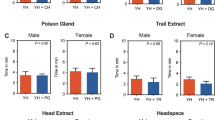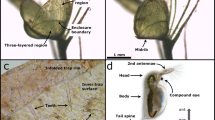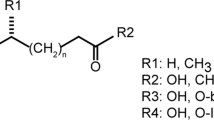Abstract
VARIOUS workers have found that the blood-feeding sexes of almost all taxa of haematophagous arthropods are attracted to and captured in traps emitting carbondioxide1–9, but so far only one female specimen of an oestrid species10 has been reported captured in an insect trap baited with CO2. Oldroyd11 has noted that, although many species of bot flies (Diptera: Oestridae) are known from grazing mammals, little is known about these parasites primarily because the adults are so rarely seen or collected. Although moderate numbers of males of certain species have been collected at mountain or hill top mating sites12,13, the rareness in collections of females captured in the wild is striking14. About the only time females are seen in the wild is the brief period when a host is visited by a larvipositing or ovipositing female.
This is a preview of subscription content, access via your institution
Access options
Subscribe to this journal
Receive 51 print issues and online access
$199.00 per year
only $3.90 per issue
Buy this article
- Purchase on Springer Link
- Instant access to full article PDF
Prices may be subject to local taxes which are calculated during checkout
Similar content being viewed by others
References
Reeves, W. C., Amer. J. Trop. Med. Hyg., 2, 325 (1953).
Wiesinger, D., Acta Trop., 13, 97 (1956).
Garcia, R., Ann. Entomol. Soc. Amer., 55, 605 (1962).
Fallis, A. M., and Smith, S. M., Canad. J. Zool., 42, 723 (1964).
Nelson, R. L., J. Med. Entomol., 2, 56 (1965).
Wilson, B. H., Tugwell, N. P., and Burns, E. C., J. Med. Entomol., 3, 148 (1966).
Kato, M., Ishii, T., Watanabe, T., and Yoshida, S., Jap. J. Sanit. Zool., 17, 83 (1966).
DeFoliart, G. R., and Morris, C. D., J. Med. Entomol., 4, 360 (1967).
Thompson, P. H., Ann. Entomol. Soc. Amer., 60, 1260 (1967).
Smith, S. M., and Bennett, G. F., Canad. J. Zool., 44, 346 (1966).
Oldroyd, H., in The Natural History of Flies, 324 (The World Naturalist, Weidenfeld and Nicolson, London, 1964).
Grunin, K. Ya., Zool. Zh., 38, 1683 (1959).
Catts, E. P., Canad. Entomol., 96, 579 (1964).
Zumpt, F., Z. Angew. Zool., 49, 393 (1962).
Bennett, G. F., and Sabrosky, C. W., Canad. J. Zool., 40, 431 (1962).
Lindsay, G. E., Proc. Calif. Acad. Sci., 30, 331 (1966).
Author information
Authors and Affiliations
Rights and permissions
About this article
Cite this article
ANDERSON, J., OLKOWSKI, W. Carbon Dioxide as an Attractant for Host-seeking Cephenemyia Females (Diptera: Oestridae). Nature 220, 190–191 (1968). https://doi.org/10.1038/220190a0
Received:
Issue Date:
DOI: https://doi.org/10.1038/220190a0
This article is cited by
-
Host Specific Cephenemyia of Deer Repelled by Non-Host Odors
Journal of Insect Behavior (2012)
-
The Response of Host-Seeking Cephenemyia Females to Visual Cues Associated with Anatomically-Modified Baited Deer Models
Journal of Insect Behavior (2012)
-
10.1007/BF00343341
CrossRef Listing of Deleted DOIs (2011)
-
Olfaction in the female sheep botfly
Naturwissenschaften (2010)
-
The two reindeer parasites,Hypoderma tarandi andCephenemyia trompe (Oestridae), have evolved similar olfactory receptor abilities to volatiles from their common host
Chemoecology (1996)
Comments
By submitting a comment you agree to abide by our Terms and Community Guidelines. If you find something abusive or that does not comply with our terms or guidelines please flag it as inappropriate.



